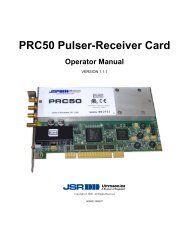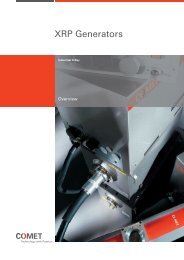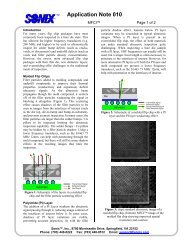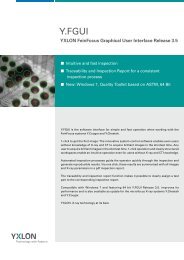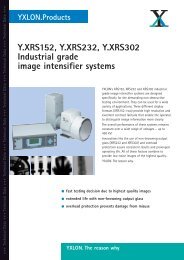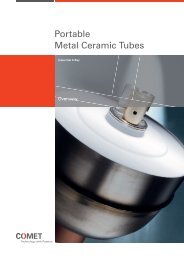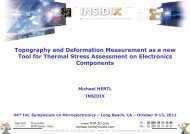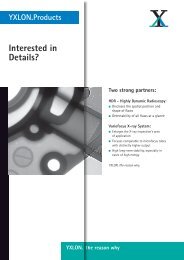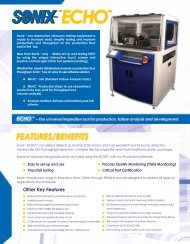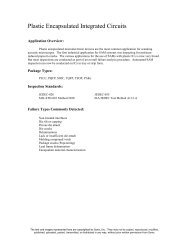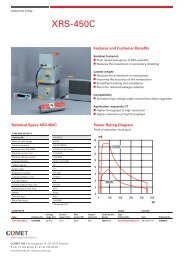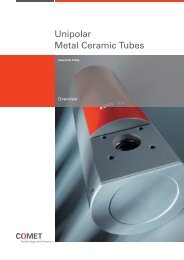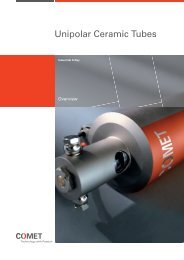SONIX Wafer Capability Brochure
SONIX Wafer Capability Brochure
SONIX Wafer Capability Brochure
You also want an ePaper? Increase the reach of your titles
YUMPU automatically turns print PDFs into web optimized ePapers that Google loves.
Scanning Acoustic Microscopy For<br />
Metrology of 3D Interconnect Bonded <strong>Wafer</strong>s<br />
Jim McKeon, Ph.D. - Sonix, Director of Technology<br />
Sriram Gopalan, Ph.D. - Sonix, Technology Engineer<br />
8700 Morrissette Drive<br />
8700 Morrissette Drive<br />
Springfield, VA 22152<br />
Springfield, VA 22152<br />
tel: : 703-440<br />
440-02220222<br />
tel: : 703-440<br />
440-02220222<br />
fax: 703-440<br />
440-9512<br />
fax: 703-440<br />
440-9512<br />
e-mail: info@sonix<br />
sonix.com<br />
e-mail: info@sonix<br />
sonix.com<br />
1<br />
TM
Ultrasonic Inspection of 3D Architectures<br />
• 3D architectures present challenges to<br />
conventional processing and inspection tools<br />
• Ultrasonic inspection is inherently a 3D technology<br />
• Ultrasound provides defect detection, metrology,<br />
and monitoring for process control<br />
2<br />
TM
Ultrasonic Inspection<br />
Ultrasound<br />
•• A transducer transducer produces produces a high high<br />
frequency frequency sound sound wave wave which which<br />
interacts interacts with with the the sample. sample.<br />
•1 •1– 300 300 MHz MHz<br />
•• High High frequency frequency sound sound waves waves can can<br />
not not propagate propagate through through air. air.<br />
Pulse Echo Inspection<br />
•A •A change change in in acoustic acoustic impedance impedance (Z) (Z)<br />
results results in in some some sound sound reflected reflected and and<br />
some some transmitted<br />
transmitted<br />
•Air •Air has has Z = 0<br />
Transducer<br />
•• Couplant- Couplant-A material material used used to to carry carry<br />
the the high high frequency frequency sound sound waves. waves.<br />
•Water •Water is is the the most most common common<br />
couplant couplant<br />
Si <strong>Wafer</strong> 1<br />
Glass wafer<br />
Si <strong>Wafer</strong> 2<br />
H 2 O<br />
Couplant<br />
3<br />
TM
SAM Capabilities<br />
Bonded wafer<br />
Si <strong>Wafer</strong> 1<br />
Si <strong>Wafer</strong> 2<br />
MEMS pressure sensor<br />
Si <strong>Wafer</strong><br />
Glass <strong>Wafer</strong><br />
Alignment of bonded wafer pair<br />
•Voiding in wafer bonding<br />
•Bond delaminations for hermetic<br />
seal applications (MEMS)<br />
•Metrology for wafer pair<br />
alignment post bonding<br />
Si <strong>Wafer</strong> 1<br />
Si <strong>Wafer</strong> 2<br />
4<br />
TM
Example Images<br />
MEMS Inspection<br />
Bonded <strong>Wafer</strong> Voiding<br />
5<br />
TM
A-Scan<br />
Initial Pulse<br />
Front surface<br />
Interface of interest<br />
Back surface<br />
Transducer<br />
Si <strong>Wafer</strong> 1<br />
Si <strong>Wafer</strong> 2<br />
The raw ultrasonic data. It is the received RF signal from a single point (x,y).<br />
6<br />
TM
C-Scan<br />
Data from a specified depth over the entire scan area. (Horizontal cross-section).<br />
7<br />
TM
Determining Void Size Distribution:<br />
Cluster Analysis<br />
•Cluster Analysis determines void size distribution based on user-defined amplitude<br />
and size criteria<br />
•Void count and percentage of void area are indicated<br />
8<br />
TM
Process Validation<br />
Original process<br />
Modified process<br />
11.664% defect area<br />
1.086% defect area<br />
9<br />
TM
Metrology<br />
Via measurement - spatial<br />
10<br />
TM
Metrology<br />
Via measurement - depth<br />
Cu velocity = 4.66 mm/µs<br />
11<br />
TM
Metrology<br />
Trench depth measurement<br />
12<br />
TM
Metrology<br />
<strong>Wafer</strong> Thickness Measurement<br />
Si velocity = 8.6 mm/µs<br />
13<br />
TM
Metrology<br />
<strong>Wafer</strong> Thickness Measurement<br />
14<br />
TM
Defect detection<br />
• Air Gap thickness<br />
•Confirmed detection of 10 nm air gaps with UHF<br />
and greater frequencies<br />
•Confirmed detection of 50 nm air gaps with<br />
25MHz and greater<br />
•Smaller Smaller air gap thickness may also be detectable<br />
• Spatial Detection<br />
•Defects Defects with diameter of few microns detectable<br />
•Resolution of closely spaced defects depends on<br />
the sample type and the transducer used<br />
15<br />
TM
Closely spaced defects<br />
•When When the pitch of the defects/ features approach<br />
the ultrasonic beam width, the resolution of the<br />
defects/features becomes challenging<br />
•The The variables affecting the beam width include:<br />
•the bonded wafer materials<br />
•thickness of the layers<br />
•Transducer selected<br />
•To To evaluate the effect of these variables for small<br />
pitch defects a calibration wafer has been<br />
developed<br />
16<br />
TM
Calibration <strong>Wafer</strong><br />
• Anodic bond<br />
• Defects etched<br />
into oxide<br />
17<br />
TM
Schematic of the device<br />
Silicon (Die 1)<br />
Air gap<br />
Bonding<br />
layer<br />
• The thickness of the Silicon (Die 1) was<br />
varied (200um, 400um, and 700um)<br />
• The feature/pitch size varied from 1-<br />
500um<br />
18<br />
TM
SAM image of the device<br />
19<br />
TM
Silicon thickness : 200um<br />
Transducer used: UHF 2mm<br />
7um pitch resolved<br />
20<br />
TM
Die thickness : 400um<br />
Transducer used: 200MHz<br />
4mm<br />
21<br />
TM
Die thickness : 400um<br />
Transducer used: 200MHz<br />
8mm<br />
22<br />
TM
Discussion<br />
• Best pitch resolution was obtained with the thinnest<br />
silicon layer<br />
• Transducer frequency was the same in each case, but<br />
the focal length had to vary due to silicon thickness<br />
23<br />
TM
Alignment of wafers in 3D<br />
metrology<br />
• <strong>Wafer</strong> alignment is typically checked<br />
pre-bonding using built-in in optical or<br />
other techniques.<br />
• Post bond inspection is of interest to<br />
ensure that the wafers are still properly<br />
aligned before adding extra cost into<br />
the product.<br />
24<br />
TM
Alignment of wafers in 3D<br />
metrology<br />
• Technologies such as Infrared (IR) and X-ray<br />
technology have been used to inspect post<br />
bond wafer alignment, but they require<br />
additional handling and process steps<br />
• Scanning Acoustic Microscopy (SAM) is<br />
widely used to evaluate the integrity of<br />
wafer bonding by detecting voids/<br />
delamination at the bonding interface<br />
• <strong>Wafer</strong> Alignment could be checked in the<br />
same step reducing process steps and cost<br />
25<br />
TM
Alignment of wafers in 3D<br />
metrology<br />
∆y<br />
∆x<br />
∆x<br />
∆y<br />
•Typically a cross / box<br />
overlay structure is used for<br />
alignment purposes<br />
•Post bonding of wafer, the<br />
variation in ∆ X and ∆ y<br />
values will determine how<br />
well the wafers have been<br />
aligned<br />
∆y<br />
∆x<br />
∆y<br />
• The actual X and Y values<br />
used can vary<br />
∆x<br />
26<br />
TM
Alignment of wafers in 3D<br />
metrology<br />
• In 3D Interconnect wafers, the<br />
alignment features are typically<br />
etched and filled with Copper on both<br />
sides<br />
• Leaving the etched features unfilled<br />
will benefit acoustic detection<br />
• This is due to the difference in acoustic<br />
impedance between air and copper<br />
27<br />
TM
Reflection vs. Transmission: Intensity Coefficients<br />
Greater Greater the the difference difference in in acoustic acoustic impedance impedance<br />
at at a boundary, boundary, greater greater the the reflection. reflection.<br />
Silicon Z 1<br />
Copper Z 2<br />
Incident Sound<br />
Reflected Sound<br />
Z 3<br />
Air<br />
Transmitted Sound<br />
Z 1<br />
= ρ C where:<br />
ρ=2.33 gram/cm 3<br />
C= 8.6 mm/µs<br />
Z 1<br />
= 2.00 g/µs cm 2<br />
Z 2<br />
= ρ C where:<br />
ρ =8.6 gram/cm 3<br />
C= 5.01 mm/µs<br />
Z 2<br />
= 4.31 g/µs cm 2<br />
Z 3<br />
= ρ C where:<br />
ρ =0 gram/cm 3<br />
C= 0.344 mm/µs<br />
Z 3<br />
= 0 g/µs cm 2<br />
Silicon - Copper boundary<br />
Ri<br />
Ri<br />
Ri<br />
=<br />
=<br />
=<br />
( Z<br />
2<br />
− Z<br />
1<br />
)<br />
( Z + Z )<br />
( 4 . 31<br />
( 4 . 31<br />
. 13<br />
2<br />
−<br />
+<br />
1<br />
2<br />
2<br />
2 . 0 )<br />
2 . 0 )<br />
2<br />
2<br />
Ri<br />
Ri<br />
Ri<br />
Silicon – Air boundary<br />
=<br />
airgap<br />
airgap<br />
( Z<br />
2<br />
− Z<br />
1<br />
)<br />
( Z + Z )<br />
2<br />
1<br />
( 0 −<br />
=<br />
( 0 +<br />
= 1<br />
2<br />
2<br />
2 . 0 )<br />
2 . 0 )<br />
2<br />
2<br />
100% refelcted<br />
versus 13%<br />
reflected<br />
28<br />
TM
Alignment of wafers in 3D<br />
metrology<br />
• As shown in the case of calibration<br />
wafer, SAM can resolve line pairs up to<br />
7um using 200 MHz 2mm transducer for<br />
Si wafer thickness of 200um<br />
• This indicates the viability of using SAM<br />
for checking the alignment of wafers<br />
post bonding to within a 7um shift<br />
29<br />
TM
Future Work<br />
• Using 300 MHz transducers finer features<br />
should be resolved allowing or finer<br />
alignment measurements<br />
• This will be tested with the calibration wafers<br />
• 3D Interconnect wafers with unfilled<br />
alignment features are being fabricated to<br />
test the viablity of SAM to measure post<br />
bonding alignment<br />
30<br />
TM
31<br />
TM



